Preface:Barton-Wright’s achievements

Edward William Barton-Wright(1860-1951)
Barton-Wright’s achievements cannot be overstated: he was probably the first to fuse Eastern and Western martial arts through the creation of bartitsu, and one of the first (if not the first) to teach Japanese martial arts in Europe. Furthermore, the martial arts shows that he organised in order to promote bartitsu can be seen as a precursor to modern mixed martial arts, or MMA, and martial arts show business. He was a man ahead of his time, but, unfortunately for him, he was maybe too ahead.
Although bartitsu quickly gained popularity in London, some people did not take him seriously and try to ridicule his techniques. For example, “Self-protection on a Cycle” (written by Marcus Tindall), also published in Pearson’s Magazine in 1901, is clearly lampooning Barton-Wright and his creation. It’s an interesting article anyway, which indirectly shows how bartitsu had already caught the public’s attention.
Ultimately, Bartitsu’s decline was as rapid as its rise had been. Barton-Wright was forced to close down his school within a few years, for financial reasons. He left however a great legacy.
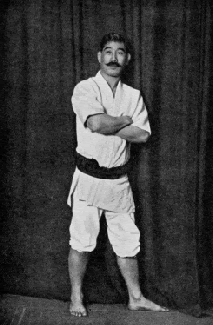
Yukio Tani (1880- 1950) Japanese Jujutsu-ka
Yukio Tani and other instructors working at Barton-Wright’s academy went on to establish their own schools and largely contributed to the promotion of martial arts in the UK. Their contributions helped increase the popularity of jujitsu in England, which in turn became the foundation for the development of judo and Japanese martial arts in Europe. In the UK in particular, this boom triggered a fever of research into Japanese martial arts, which lead to the publishing of many books. Among them notably, The Fighting Man of Japan (F.J. Norman, 1905) and The Fighting Spirit of Japan (Ernest John Harrison, 1912) are considered to be the first books on Japanese martial arts published in English.

The Fighting Man of Japan (F.J. Norman, 1905)
In the 2000’s, literature about bartitsu surfaced again, leading to a renewed interest in this almost forgotten martial arts. An international association called the Bartitsu Society was established by a group of enthusiasts, who endeavoured to research its history and revive its technical syllabus, bringing bartitsu back into the spotlight.
With this in mind, I would like to introduce and translate here elements of Barton-Wright’s “Self-Defense with a Walking-Stick: The Different Methods of Defending Oneself with a Walking-Stick or Umbrella when Attacked under Unequal Conditions”. I hope you will enjoy the beauty and the efficiency of the stick techniques.
Text and Translation by Naoko Mikami
Japan Text Treasure Finders, a new initiative by C Hub Japan, is led by Naoko Mikami. Fluently bilingual, she holds a BA in Japanese Literature from Nihon University. After 25 years working at International Budo University, Japan’s foremost martial arts school, famed for its collection of ancient scrolls that document the history of martial arts, Naoko is pursuing her lifelong passion for historical research.
www.japantextfinders.com
Self-Defense with a Walking-Stick
The Different Methods of Defending Oneself with a Walking-Stick or Umbrella when Attacked under Unequal Conditions.
By E.W. Barton-Wright
Self-Defense with a Walking-Stick By E.W. Barton-Wright Vol.1
No. 11 — The Safest Way to Meet an Attack with a Spiked Staff or Long Stick when you are only Armed with an Ordinary Walking Stick.

The first photograph shows the most dangerous mode of attack with a long stick, and also the best position to adopt in order to meet such an attack with safety.
It will be seen that the figure on the right is exposing his body in order to insure his adversary attacking him there, and to be prepared with an immediate defence.
Directly the man with the alpenstock attempts to bayonette him, he diverts the blow by turning sideways, and making a circular downward cut, which hits the alpenstock and causes it to glide slightly upwards and sideways — a guard known in sword play as “Septime envelopé.” The moment the blow has been diverted, the man with the stick must seize the alpenstock with his left hand, and, stepping in, strike his assailant a blow across the face.
No. 12. An Effective Way to Defend Oneself with a Hooked Stick when Attacked by a Man Armed with an Ordinary Straight Stick.
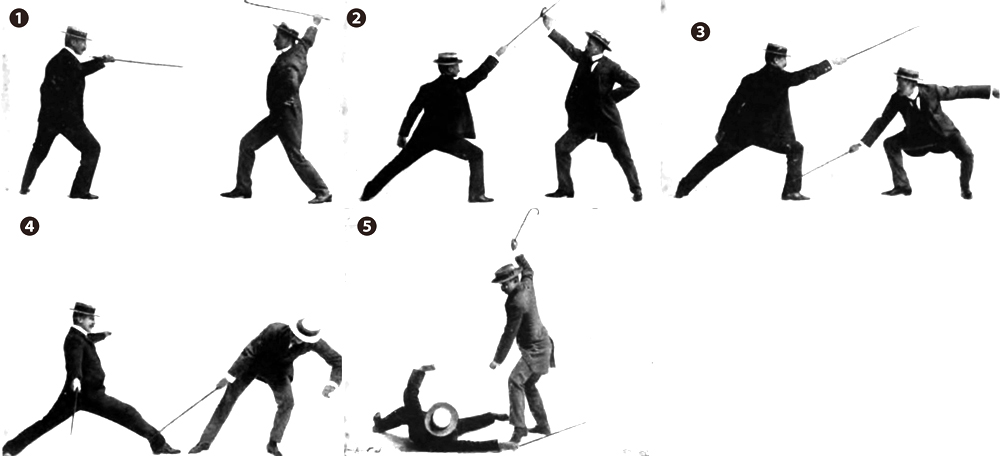
A stick with a curved handle, forming a roomy crook, although hardly so effective as a stick with a heavy knob on top for striking purposes, is a most serviceable weapon in the hands of an expert in the art of stick-play.
Having guarded a blow with a hooked stick, it is a comparatively simple matter to hook an assailant in such a way that he is easily pulled off his balance. With a little practice it becomes easy to make sure of hooking a man firmly by the neck or leg.
Suppose, for instance, that a man carrying a crooked stick is suddenly attacked by an assailant armed with an ordinary straight stick. Here is a very pretty way to overthrow the assailant:
In the first place, the man with the hooked stick should hold his hand and stick high up, and well on one side, so as not to run any risk of being hit on the fingers.
By doing this, he purposely exposes his head to attack. Knowing, therefore, that his opponent is sure to strike at his head, he is prepared for a quick guard. The attacker delivers his blow and is received upon the stick; but before he has time to recover himself, and get into a position of defence, the other suddenly ducks and hooks him by the foot, on the outer side of the ankle, bringing him to the ground by pulling his legs apart.
The assailant is then at the mercy of the man he has attacked, who can choose any part of his body on which to administer punishment.
No. 13. — The Best Way to Disable a Man who Tries to Rush You, and get under your Guard, in order to Prevent You Hitting him with a Hooked Stick.
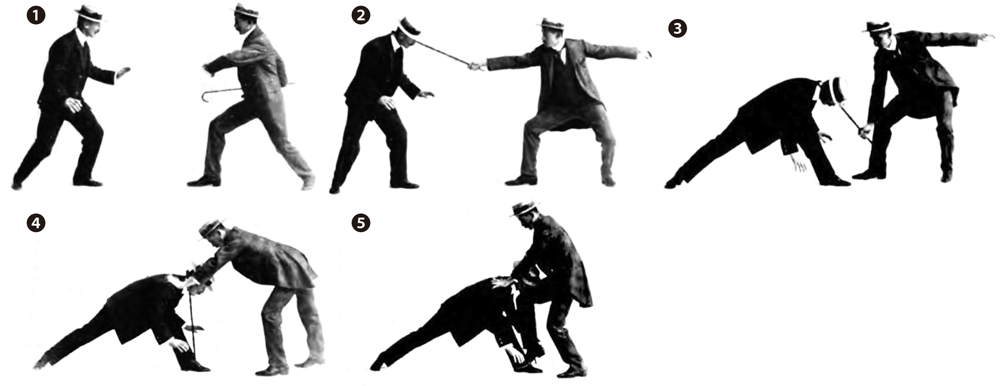
The first photograph shows the best position to adopt in order to meet a sudden spring and prevent an assailant from seizing your stick.
As a feint, you make a slightly threatening motion with your left hand, as though you intended to seize the left hand of your assailant, in order to belabor him with your stick. The object of this feint is only to engage your adversary’s attention, and make him look at your left hand whilst you suddenly dart your right arm forward, and hook him by the neck in the crook of your stick. Directly you have hooked him, bend your knees well so as to throw the whole weight of your body upon him, whilst you pull him with his face towards the ground.
When you have pulled him down sufficiently far to prevent him recovering his balance quickly, let go your stick, and seize him by the shoulders, as shown in photo No. 4, being careful to keep your feet well out of reach of his hands, so as not to give him the opportunity of throwing you backwards. Then, with a sudden jerk, pull him forwards, and simultaneously jumping close into him, strike him with your knee in the face.
It is necessary to be very careful when practicing this trick, as the slightest blow with the knee in a person’s face is sufficient to break a nose and several teeth.
Of course the reader will understand that in any method of self-defence it is necessary to know how to maintain the proper distance between yourself and your assailant, in order to deliver a coup-de-grâce with effect and certainty. This knowledge, together with the confidence, dash, and savoir-faire that are so essential, can only be acquired by practice; but, when once gained, it is never lost.
No. 14. — How to Use a Walking-Stick as a Weapon in a Crowd.
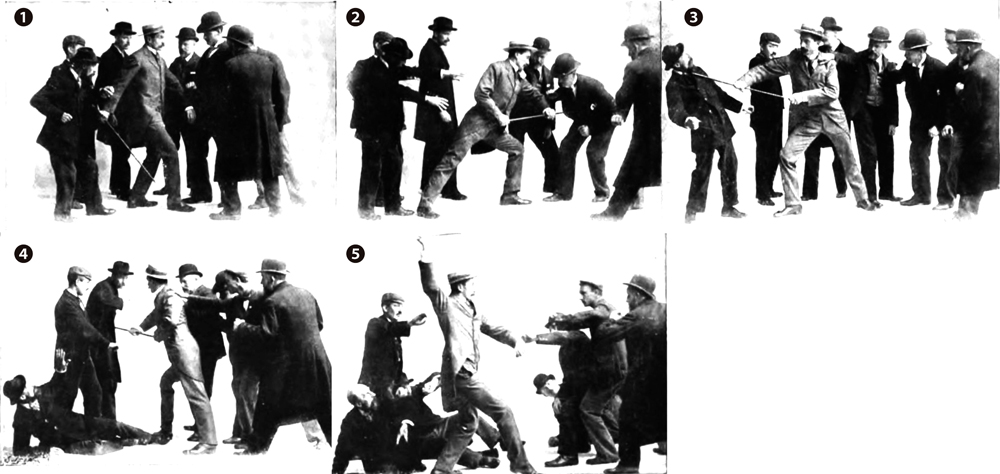
It will be understood that it is quite impossible to swing a stick in a crowd, owing to want of elbow room; and so, in order to get elbow room and free scope to hit, you proceed as follows: —
Hold your stick, more or less in a line with your hips, and proceed, as in the second photograph, to lunge to your left, holding the end of the stick in your right hand, and letting it slide through your left, in order to be able to guide it with certainty.
Lunging at the body of the nearest man on your left, you disable him, and cause him to retreat precipitously. In doing so, he involuntarily forces back those in his immediate neighborhood. You then turn on your heels, and bayonette the nearest man on your right, this time holding the end of your stick in your left hand, and guiding it through your right. Directly you have bayonetted him, and caused him to force back others in his attempt to escape, you make a quarter turn on your heels, and bayonette the man behind you.
After this, seeing another man close to him with his legs slightly apart, you make a dive with your stick between his legs, and upset him. Take one step backwards, and you should now have sufficient room to swing your stick to right and left across people’s faces and heads until they disperse.
No. 15. — A very Simple Way to Protect Yourself with a Hooked Walking Stick against a Boxer.
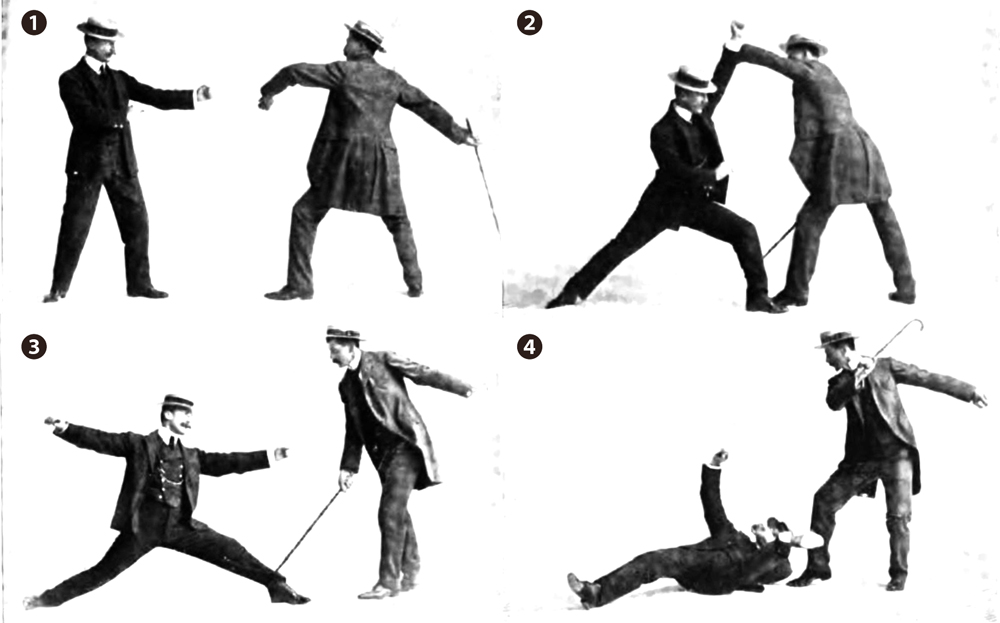
When carrying a hooked stick, here is a very simple way to protect yourself against the attack of an unarmed assailant.
Hold your stick behind you, as seen in the first photograph, so as to run no risk of the stick-arm being seized. Bend your left arm with the inside of the left hand facing outwards in order to protect yourself from a kick at the hip, or a blow from the fist at your face or ribs.
Hold your stick behind you, as seen in the first photograph, so as to run no risk of the stick-arm being seized. Bend your left arm with the inside of the left hand facing outwards in order to protect yourself from a kick at the hip, or a blow from the fist at your face or ribs.
You have now the opportunity, and plenty of time, to hook him by the ankle with your stick, as seen in the second photograph. Having so hooked his foot, pull his legs apart, and bring him to the ground, when you can apply the stick where and how you please.
No. 16. — How to Overcome the Advantage of an Assailant who Attacks You with a Stout Stick when You are Carrying only a Light Cane.
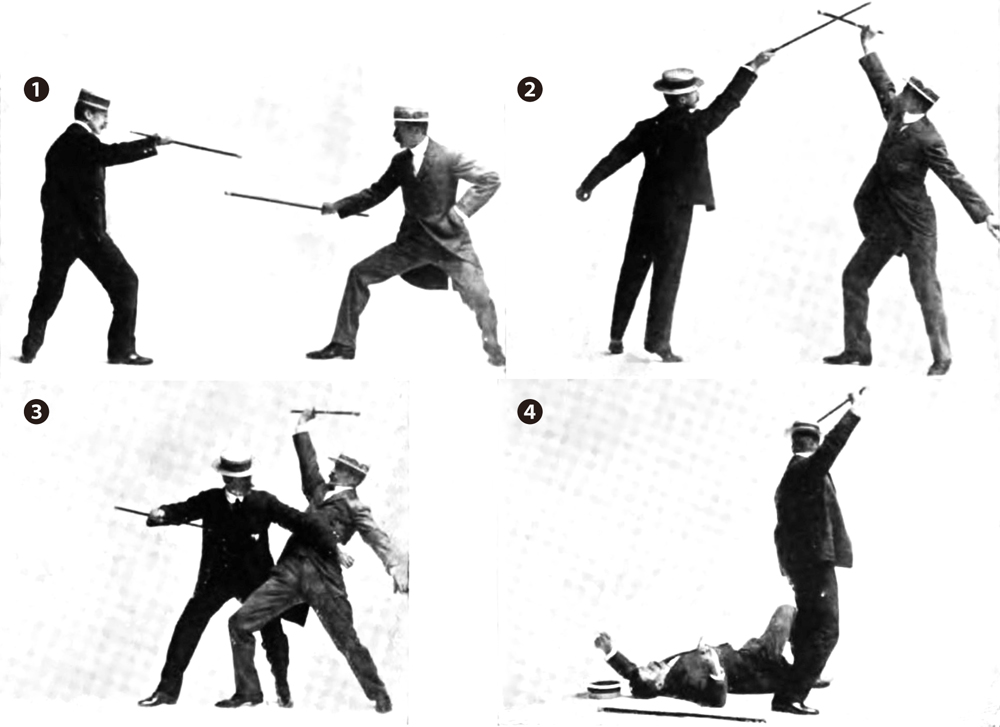
When threatened with an attack from an assailant who is armed with a superior stick to your own, it is wise to attack him before he realises that he has you at a disadvantage.
To do so to the best effect you should lead off with aright-handed blow at your assailant’s head, thereby forcing him to guard high. At the same moment you should jump in one movement from the position shown by the figure to the left of photo No. 2 to the position shown by the same figure in photo No. 3 — a very simple and easy movement. In making this spring you must be careful to keep your head down and on one side.
As soon as you are in the position shown in photo No. 3, without making any attempt to lift your adversary in order to throw him, simply strike your knee smartly against the back of his knee; this will have the effect of knocking his leg from beneath him. As he reels about on his left leg trying to regain his balance, put plenty of force into your left arm, and throw him upon the back of his head. He will immediately put out both his hands to try to break his fall, and in so doing will drop his stick.
In this way you accomplish your purpose and disarm your adversary. You can now give him his coup-de-grâce as you please. The surest way is to deal him a blow across his ankle or just below the knee.
No. 17. — Another Way, when Armed with a Light Cane, to Disarm and Overpower an Opponent who carries a Superior Stick.

Suppose once again that, when carrying only a light cane, you are attacked by an assailant armed with a stronger and more serviceable stick. In order to rob him of his advantage you immediately proceed as described in the last example by aiming a high blow at your opponent’s head, thus causing him to guard high.
Now spring in one bound under his guard to the position shown in photo No. 2. Passing your left hand over his right forearm, placing your right hand against his wrist, and at the same time seizing your own right wrist in your left hand, you thus firmly “lock” your adversary’s arm. All this is done without loosening the hold upon your own stick, and without seizing your opponent’s arm in any way with your hand — yet the lock is so powerful that the strongest man would be a child in your hands when you properly apply the leverage you may obtain from this position.
To apply the leverage correctly, you should force your opponent’s elbow towards you with your left arm, and at the same time force his right hand downwards and from you, with the “lock” formed by your left hand in holding your right wrist.
The pain and strain from this grip is so excruciating that your opponent will fall upon his back, only too thankful thus to escape the danger of a broken arm. He is then at your mercy, and you may apply your stick or your foot, as circumstances may dictate.
This, and the preceding method of self-defense with a walking-stick, may be practised upon a swordsman armed with a sword or a dagger with absolute certainty of success. Personally, I have tried one or other of these examples time after time against good swordsmen, and have never failed to bring the trick through successfully. Of course, your success, or otherwise, will depend to some extent upon the quickness, dash, and power with which you execute the assault.
No. 18. — One of the Best Ways to Meet a Direct Attack upon the Head with a very Heavy Stick when Armed with an Ordinary Stick.
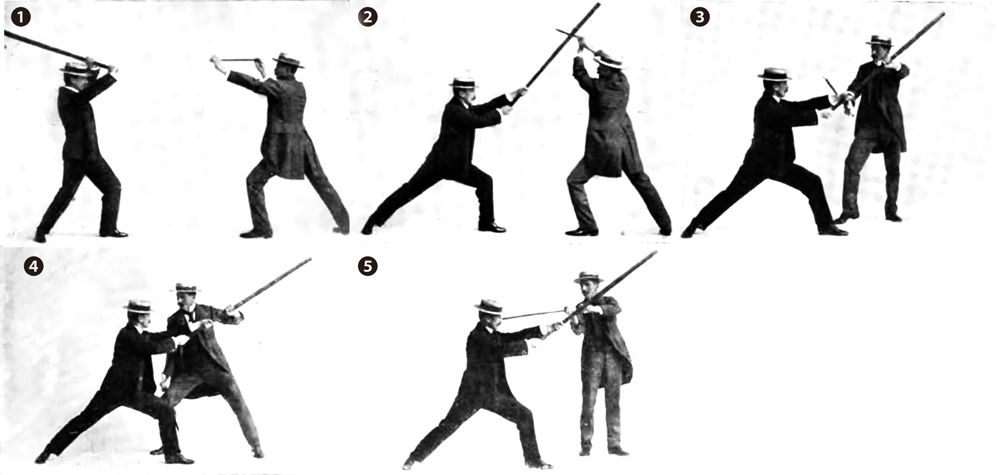
The first photograph shows a man armed with a heavy stick in the act of striking at the head of a man armed with a walking-stick. The latter is standing in the double-handed position of guard; and it will be noticed that in holding his weapon he places his hands so that the back of his left hand is on the side nearest his face, and the back of his right hand on the side farthest from his face; in other words, the positions of his hands are reversed.
Directly the assailant delivers his blow, the man with the walking-stick slides his stick through his right hand until has hands meet, and then twists the stick without altering his hold in any way so that his right hand passes over his left. In this position, with his wrists crossed, he holds the stick above his head, to receive the downward cut delivered by his adversary.
Directly he has guarded the blow, and so broken the force of it, letting go the stick with the left hand, with this hand he seizes the assailant’s staff. Retaining hold of the stick with his right hand, the man attacked may then break his opponent’s wrist with a heavy blow, as seen in Photograph No. 3.Another method is to let the blow fall across the assailant’s kneecap, as seen in photograph No. 4.
Still another way to proceed is for the man attacked to continue to use his own weapon with both hands, and to deliver a heavy blow across his adversary’s face, as shown in the last photograph.
No. 19. — A very Serviceable Way to Disable a Taller Man than Yourself when Opposed to Him under Unequal Conditions.
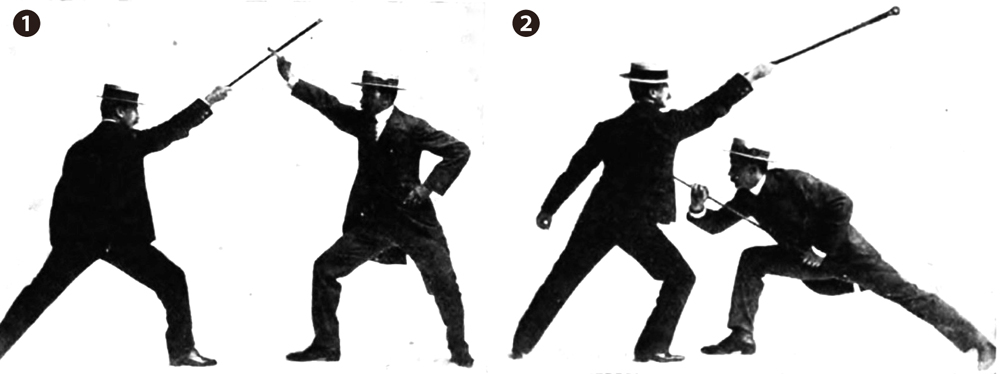
Directly you have had time to catch your opponent’s eye and judge your striking distance, you must expose your head, either by slightly lowering your guard, or by holding your hand and stick well on one side, so as to invite an attack on your head. You must rely on your own quickness to protect your head when the blow falls.
Directly your opponent sees the opening, he will lead off at your head. You protect yourself by receiving the blow upon your stick, as seen in the first photograph. Then, without losing any time, drop into the next position, and bayonette your assailant over the heart.
No. 20. — Example of a very Pretty Guard and Counter-blow when an Assailant Directs a Blow at your Head with a Stick.

When an assailant attempts to strike you on the head with his stick, you may receive the blow upon your stick by bringing your hand right across your face, and holding it well on the left side of your head with the back of your hand outwards, facing your opponent. Your stick should point slightly downwards to prevent your opponent’s stick sliding down yours, and striking you on the fingers. The moment you have done this you step slightly towards your opponent’s right side with your right foot, and describe a circular right to left back-handed cut across his face, which should be sufficient to prevent him troubling you any further.
No. 21. — An Example of the Double-Handed Guard in Combination with Ambi-Dexterity.
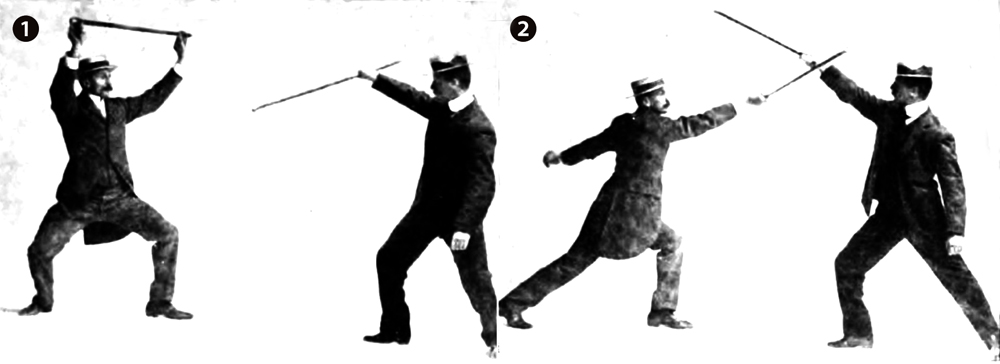
In this example the man on the left in the photograph is seen taking up the double handed guard, but his assailant refuses to accept the invitation at his body, although it is exposed — instead of this he aims a blow at the left wrist, or the left side of the head. On this the man with the double-handed guard, in order to avoid being hit upon the fingers, lets go of the left-hand end of his stick, and swings his left hand behind him — a movement which automatically imparts the initial movement for a right-handed blow. This he delivers across his opponent’s wrist, which he would thus break, just as the assailant is in the act of striking.
No. 22. — Another Example of the Double-Handed Guard in Combination with Ambi-Dexterity.
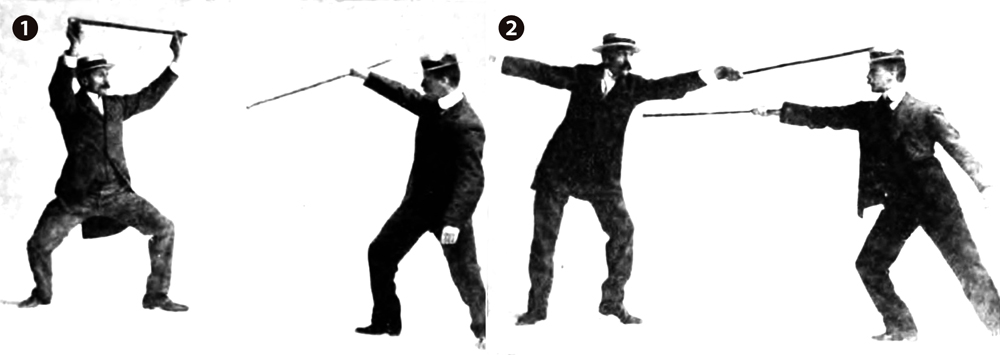
In this example, the defender, as in No. 11, invites an attack at his body by guarding his head in an exaggerated way, and so exposing his body. His opponent immediately attempts to take advantage of the opening by striking at the exposed body, when the other simply draws his left foot towards his right, and so retires out of striking distance of his adversary. Then, by releasing his hold on the stick down heavily with his left upon his assailant’s head, as seen in the lowest photograph.
Concluding Note.
With reference to the short description of walking-stick play, and the tricks described in this and the preceding number of Pearson’s Mag, I may state that the art of self-defence with a walking-stick is particularly adapted to conditions where a man is attacked by more than one person. It can be readily acquired, either by men or women, and when once mastered would enable you to defend yourself, with absolute safety, against a knife, boxing, savate, etc. The more dangerous methods have not been shown.
Besides being a most useful and practical accomplishment, this new art of self-defence with a walking-stick is to be recommended as a most exhilarating and graceful exercise.


















